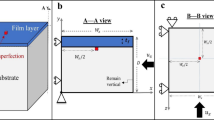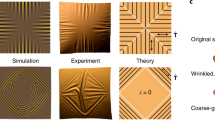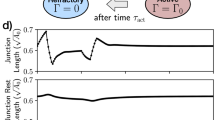Abstract
Spatially confined rigid membranes reorganize their morphology in response to the imposed constraints. A crumpled elastic sheet presents a complex pattern of random folds focusing the deformation energy1, whereas compressing a membrane resting on a soft foundation creates a regular pattern of sinusoidal wrinkles with a broad distribution of energy2,3,4,5,6,7,8. Here, we study the energy distribution for highly confined membranes and show the emergence of a new morphological instability triggered by a period-doubling bifurcation. A periodic self-organized focalization of the deformation energy is observed provided that an up–down symmetry breaking, induced by the intrinsic nonlinearity of the elasticity equations, occurs. The physical model, exhibiting an analogy with parametric resonance in a nonlinear oscillator, is a new theoretical toolkit to understand the morphology of various confined systems, such as coated materials or living tissues, for example wrinkled skin3, internal structure of lungs9, internal elastica of an artery10, brain convolutions11,12 or formation of fingerprints13. Moreover, it opens the way to a new kind of microfabrication design of multiperiodic or chaotic (aperiodic) surface topographythrough self-organization.
This is a preview of subscription content, access via your institution
Access options
Subscribe to this journal
Receive 12 print issues and online access
$259.00 per year
only $21.58 per issue
Buy this article
- Purchase on SpringerLink
- Instant access to full article PDF
Prices may be subject to local taxes which are calculated during checkout



Similar content being viewed by others
References
Witten, T. A. Stress focusing in elastic sheets. Rev. Mod. Phys. 79, 643–675 (2007).
Bowden, N., Brittain, S., Evans, A. G., Hutchinson, J. W. & Whitesides, G. M. Spontaneous formation of ordered structures in thin films of metals supported on an elastomeric polymer. Nature 393, 146–149 (1998).
Cerda, E. & Mahadevan, L. Geometry and physics of wrinkling. Phys. Rev. Lett. 90, 074302 (2003).
Vandeparre, H. et al. Slippery or sticky boundary conditions: Control of wrinkling in metal-capped thin polymer films by selective adhesion to substrates. Phys. Rev. Lett. 99, 188302 (2007).
Vandeparre, H. & Damman, P. Wrinkling of stimuloresponsive surfaces: Mechanical instability coupled to diffusion. Phys. Rev. Lett. 101, 124301 (2008).
Huang, J. et al. Capillary wrinkling of floating thin polymer films. Science 317, 650–653 (2007).
Jiang, H. et al. Finite deformation mechanics in buckled thin films on compliant supports. Proc. Natl Acad. Sci. 104, 15607–15612 (2007).
Pocivavsek, L. et al. Stress and fold localization in thin elastic membranes. Science 320, 912–916 (2008).
Diamant, H., Witten, T. A., Ege, C., Gopal, A. & Lee, K. Y. C. Topography and instability of monolayers near domain boundaries. Phys. Rev. E 63, 061602 (2001).
Strupler, M. et al. Second harmonic microscopy to quantify renal interstitial brosis and arterial remodeling. J. Biomed. Opt. 13, 054041 (2008).
Richman, D. P., Stewart, R. M., Hutchinson, J. W. & Caviness, V. S. Jr Mechanical model of brain convolutional development. Science 189, 18–21 (1975).
Toro, R. & Burnod, Y. A morphogenetic model for the development of cortical convolutions. Cereb. Cortex 15, 1900–1913 (2005).
Kücken, M. & Newell, A. C. A model for fingerprint formation. Europhys. Lett. 68, 141–146 (2004).
Efimenko, K. et al. Nested self-similar wrinkling patterns in skins. Nature Mater. 4, 293–297 (2005).
Feigenbaum, M. J. Quantitative universality for a class of nonlinear transformations. J. Stat. Phys. 19, 25–52 (1978).
Feigenbaum, M. J. The universal metric properties of nonlinear transformations. J. Stat. Phys. 21, 669–706 (1979).
Libchaber, A., Laroche, C. & Fauve, S. Period doubling cascade in mercury, a quantitative measurement. J. Physique 43, L211–L216 (1982).
Guevara, M. R., Glass, L. & Shrier, A. Phase locking, period-doubling bifurcations, and irregular dynamics in periodically stimulated cardiac cells. Science 214, 1350–1353 (1981).
Fox, J. J., Bodenschatz, E. & Gilmour, R. F. Period-doubling instability and memory in cardiac tissue. Phys. Rev. Lett. 89, 138101 (2002).
Berger, C. M. et al. Period-doubling bifurcation to alternans in paced-cardiac tissue: Crossover from smooth to border-collision characteristics. Phys. Rev. Lett. 99, 058101 (2007).
Melo, F., Umbanhowar, P. B. & Swinney, H. L. Hexagons, kinks, and disorder in oscillated granular layers. Phys. Rev. Lett. 75, 3838–3841 (1995).
Venkataramani, S. C. & Ott, E. Spatiotemporal bifurcation phenomena with temporal period doubling: Patterns in vibrated sand. Phys. Rev. Lett. 80, 3495–3498 (1998).
Gilet, T. & Bush, J. Chaotic bouncing of a droplet on a soap film. Phys. Rev. Lett. 102, 014501 (2009).
Losert, W., Shi, B. Q. & Cummins, H. Z. Spatial period-doubling instability of dendritic arrays in directional solidification. Phys. Rev. Lett. 77, 889–891 (1996).
Hutchinson, J. W. & Koiter, W. T. Postbuckling theory. Appl. Mech. Rev. 23, 1353–1366 (1970).
Groenewold, J. Wrinkling of plates coupled with soft elastic media. Physica A 298, 32–45 (2001).
McLachlan, N. W. Theory and Application of Mathieu Functions (Dover, 1962).
Blanch, G. Chapter 20: Mathieu Functions. in Handbook of Mathematical Functions with Formulas, Graphs, and Mathematical Tables (ed. Abramowitz, M.) (Dover, 1972).
Sanmartín, J. R. O Botafumeiro: Parametric pumping in the middle ages. Am. J. Phys. 52, 937–945 (1984).
Van den Broeck, C. & Bena, I. in Stochastic Processes in Physics, Chemistry, and Biology 557 (eds Freund, J. A. & Pöschel, T.) 257–267 (Lect. Notes Phys., 2000).
Acknowledgements
The authors thank T. Witten, B. Davidovitch, H. Diamant, S. Desprez, C. Troetsler, S. Gabriele and G. Carbone for discussions. This work was supported by the Belgian National Funds for Scientific Research (Mandat Impulsion Scientifique), the Government of the Region of Wallonia (CORRONET and REMANOS Research Programmes) and the European Science Foundation (Eurocores FANAS programme, EBIOADI collaborative research project). F.B. acknowledges financial support from a return grant delivered by the Federal Scientific Politics.
Author information
Authors and Affiliations
Contributions
F.B. and P.D. designed the experiments; F.B., H.V., A.S. and C.P. carried out the experiments; F.B., A.B. and P.D. developed the theoretical model; F.B. and P.D. wrote the manuscript.
Corresponding author
Ethics declarations
Competing interests
The authors declare no competing financial interests.
Supplementary information
Supplementary Information
Supplementary Information (PDF 508 kb)
Supplementary Information
Supplementary Movie 1 (MOV 552 kb)
Rights and permissions
About this article
Cite this article
Brau, F., Vandeparre, H., Sabbah, A. et al. Multiple-length-scale elastic instability mimics parametric resonance of nonlinear oscillators. Nature Phys 7, 56–60 (2011). https://doi.org/10.1038/nphys1806
Received:
Accepted:
Published:
Issue Date:
DOI: https://doi.org/10.1038/nphys1806
This article is cited by
-
Growth-induced instabilities for transversely isotropic hyperelastic materials
Mechanics of Soft Materials (2023)
-
Mechanics of micropattern-guided formation of elastic surface instabilities on the polydimethylsiloxane bilayer
Advanced Composites and Hybrid Materials (2023)
-
Modeling the Behavior of an Extensible Sheet in a Pressurized Chamber
Journal of Elasticity (2023)
-
Chiral topographic instability in shrinking spheres
Nature Computational Science (2022)
-
Post-buckling behaviors of thin-film soft-substrate bilayers with finite-thickness substrate
Scientific Reports (2022)



